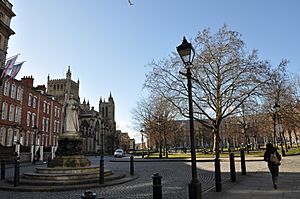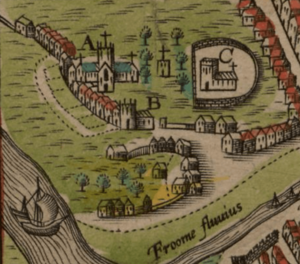Jordan of Bristol facts for kids
Quick facts for kids Saint Jordan of Bristol |
|
|---|---|

Icon by Helen McIldowie-Jenkins, displayed at Bristol Cathedral
|
|
| Confessor | |
| Residence | Bristol region, England |
| Venerated in | Historically, Roman Catholicism; currently, the Church of England's Diocese of Bristol |
| Major shrine | Chapel of St. Jordan, College Green, Bristol (no longer extant); Bristol Cathedral |
| Attributes | Youth, Roman, noble, the habit and tonsure of a monk, hand raised in blessing, bearing bread and wine, companion of Augustine of Canterbury |
| Patronage | The city of Bristol and College Green; the English people and the English church |
|
Catholic cult suppressed
|
1539, the Dissolution of the Monasteries |
Jordan of Bristol (Latin: Iordanus) was a saint honored in Bristol, England. People respected him before the Reformation, a time of big changes in the English church. We don't know much for sure about him.
Many stories say Jordan was a friend of Augustine of Canterbury. Augustine came to South West England in the early 600s. He helped spread Christianity. Jordan is said to have founded a church in the Bristol area. Later, people began to see him as a saint. We know a chapel named after Jordan existed in Bristol in the 1300s.
Starting in the 1800s, some historians began to question these old stories. They suggested different ideas about who Jordan might have been. Others, however, continued to believe the traditional tales.
Contents
Who Was Saint Jordan?
It's not clear where Jordan came from or how he became a saint in Bristol. A hymn from the 1400s says he was a friend of Augustine of Canterbury. This hymn states that Jordan helped teach the Christian message to the English people. It also says his relics (holy remains) were buried in Bristol.
Jordan as Augustine's Companion
David H. Higgins, a historian from Bristol University, thinks Jordan might have been a young monk. He may have belonged to a noble family called Jordan. This monk lived at St. Andrew's Monastery in Rome. Higgins believes Jordan traveled with Augustine on the Gregorian mission. This mission aimed to convert the English to Christianity.
Higgins looked at place names and old writings from the 1500s. These writings were by John Leland and William Camden. He suggested Jordan traveled with Augustine to West England. They went there for an important meeting with Celtic bishops. After this meeting, Jordan might have started the first monastery in the Bristol area. He may have stayed there.
Some people wonder why Jordan isn't mentioned in Bede's Ecclesiastical History of the English People. This book is a key history of the early English church. Higgins explained that Jordan might have been a younger monk. He might not have been a priest or deacon yet. His work might have been more focused on local people. It might not have had the "political weight" to be in Bede's history.
Higgins also pointed out other reasons for the lack of information. Jordan was in an isolated area. He was among mostly non-Christian people. He might have died before a big church meeting in 664. Also, Bede might have had biases against some Christian groups Jordan worked with.
Other Ideas About Jordan's Identity
Historian Michael Hare has a different idea. He thinks Jordan was probably a hermit (someone who lives alone for religious reasons). Hare believes Jordan lived in a chapel on College Green in the 1200s or 1300s. According to Hare, the idea that Jordan was Augustine's companion came later, from the 1400s hymn writer.
In 1899, George Edward Weare suggested Jordan might have been related to Robert Fitzharding. Fitzharding founded St. Augustine's Abbey in Bristol. Weare thought the chapel on College Green might have been built by Jordan or as a memorial to him. Weare believed the monks of St. Augustine's Abbey made Jordan a saint. This would have made their abbey seem more important.
A. S. Ellis, who studied family histories, agreed with this idea. He thought Jordan, Robert Fitzharding's brother, might have been a monk. Or he might have built the chapel to live there as a hermit. If this is true, Jordan would have been the son of Harding of Bristol. He would also be the grandson of Eadnoth the Staller. Eadnoth was an important Anglo-Saxon official. We don't know much about this Jordan Fitzharding. He was involved in a local court case between 1176 and 1183.
How Saint Jordan Was Honored
People have long thought that Jordan's worship started very early. But the first clear proof of his cult is from 1393. A widow named Agnes Spelly left money to Saint Jordan's chapel on College Green. Later records from St. Augustine's Abbey in Bristol also mention Jordan. In 1491–92, money was taken "from the pyx within St. Jordan's chapel on the green." In 1511–12, offerings were made to Jordan in a side chapel of the abbey.
M. R. James found a hymn and a special prayer (collect) for Jordan. They were in a Bristol Book of Hours (a prayer book). These were used in the chapel on College Green in the 1400s. Part of the hymn says:
O Jordan, blessed confessor of Christ and citizen of Heaven, intercede for us by virtue of the faith we of the English church profess, whom Augustine [first] baptised and you perfected in that holy trust, whose colleague (alt. companion) you were in his preaching to the English. Be our Patron [saint] in this place where you lie entombed.
David H. Higgins said this hymn and prayer confirm something important. They show that the church officially believed Saint Jordan worked with Saint Augustine. He helped spread Christianity in the west of England. They also believed he was a "Confessor of the Faith." This means he openly declared his faith. The hymn also says Jordan's tomb was in his chapel on College Green.
The name Jordan became popular in England. This was because pilgrims returned from the Holy Land with water from the Jordan River. But Peter Fleming, a historian, noted that the name Jordan was very common in Bristol in the 1100s. Especially among the noble Fitzharding and Berkeley families. He thinks this shows that Saint Jordan was very important in the city.
Fleming pointed out that four people in Robert Fitzharding's family were named Jordan. Robert Fitzharding founded St Augustine’s Abbey. The abbey was near College Green, where Jordan's chapel and tomb were. Fleming believes this shows that the saint's worship existed in Bristol early on. It also had the support of powerful local families. People in Bristol continued to name their sons Jordan even into the 1400s.
Fleming concluded that College Green was the main place for Saint Jordan's worship. During Lent and Easter, the mayor and city leaders would attend sermons there. The Berkeley family also had a special devotion to the saint.
Samuel Seyer, an early 1800s historian of Bristol, agreed. He thought Jordan, Robert Fitzharding's brother, was named after an earlier saint. Seyer strongly believed this earlier saint was part of Augustine's mission. He wrote that it was very likely Robert Fitzharding named his abbey after St. Augustine. And that Harding, Robert's father, named his son Jordan after Augustine's companion.
Despite these signs, Fleming said we don't know exactly how much Bristolians honored Jordan. His name isn't linked to other places in Bristol. He's also not mentioned in an important local record called Ricart's Kalendar. This might mean Jordan was seen as a saint mainly for the Berkeley family or north Bristol. He might not have been seen as a saint for all of Bristol.
Today, Bristol Cathedral has an icon (a religious painting) of St. Jordan. It's in the Elder Lady Chapel. Helen McIldowie-Jenkins painted it. In 2012, the BBC, Bristol Cathedral, and the University of Bristol called Jordan "the patron saint of Bristol."
Is the Story of Saint Jordan True?
In 2012, archaeologists started digging at College Green in Bristol. The Dean of Bristol Cathedral, David Hoyle, hoped they might find Jordan's chapel or relics. They didn't find any evidence. The Bristol City Council website explains why. Any proof of St. Jordan's chapel was destroyed. This happened when College Green was leveled to build the Council House in 1950.
However, old maps of Bristol from the 1600s show where St. Jordan's chapel used to be. These maps were made by John Speed and James Millerd. John Speed's map from 1610 matches a description by William Camden. Camden described the chapel's location as a "green plain." It had trees and a stone pulpit. He also mentioned a chapel where Jordan, Augustine's companion, was said to be buried.
Because Jordan isn't in important texts like Bede's Ecclesiastical History of the English People, Michael Hare thinks the story of him being Augustine's companion is made up. Hare believes Jordan was probably a local saint from the late Middle Ages. Gwen Beachcroft and Arthur Sabin, from the Bristol Record Society, had another idea in 1938. They thought the story of Saint Jordan, Augustine's student, might have been invented. This would have made the land around St. Augustine's Abbey seem more holy.



